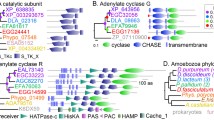Summary
The cell covering (or periplast) of many cryptomonads consists of discrete plate areas precisely arranged over most of the cell periphery. Developmental changes in periplast arrangement that occur throughout the cell cycle are examined here forKomma caudata andProteomonas sulcata [haplomorph]. In both cryptomonads, pole reversal occurs during cytokinesis, necessitating major realignment of the plate areas. Growth of the periplast occurs by addition of new plate areas to specialized regions (termed anamorphic zones) located around the vestibular margins and along the mid-ventral line of cells. Development of the periplast from these regions enables elongation and lateral expansion of cryptomonads throughout cell growth. Observed differences in cell division and periplast development between these genera are closely associated with variations in the arrangement of anamorphic zones.
Similar content being viewed by others
References
Brett SJ, Wetherbee R (1986) A comparative study of periplast structure inCryptomonas cryophila andC. ovata (Cryptophyceae). Protoplasma 131: 23–31
— — (1996a) Periplast development in Cryptophyceae II. Development of the inner periplast component inRhinomonas pauca, Proteomonas sulcata [haplomorph],Rhodomonas baltica, andCryptomonas ovata. Protoplasm: 192: 40–48
— — (1996b) Periplast development in Cryptophyceae III. Development of crystalline surface plates inFalcomonas daucoides, Proteomonas sulcata [haplomorph] andKomma cauda. Protoplasma 192: 49–56
Cohn SA, Spurck TP, Pickett-Heaps JD, Edgar LA (1989) Perizonium and initial valve formation in the diatomNavicula cuspidata (Bacillariophyceae). J Phycol 25: 15–26
Faust MA (1974) Structure of the periplast ofCryptomonas ovata var.palustris. J Phycol 10: 121–124
Gantt E (1971) Micromorphology of the periplast ofChroomonas sp. (Cryptophyceae). J Phycol 7: 177–184
Grim JN, Staehelin LA (1984) The ejectisomes of the flagellateChilomonas paramecium: visualization by freeze-fracture and isolation techniques. J Protozool 31: 259–267
Guillard RRL, Ryther JH (1962) Studies on marine planktonic diatoms. I.Cyclotella nana Hustedt, andDetonula confervacea (Cleve) Gran. Can J Microbiol 8: 229–239
Hausmann K, Walz B (1979) Periplaststruktur und Organisation der Plasmamembran vonRhodomonas spec. (Cryptophyceae). Protoplasma 101: 349–354
Hibberd DJ, Greenwood AD, Griffiths HB (1971) Observations on the ultrastructure of the flagella and periplast in the Cryptophyceae. Br Phycol J 6: 61–72
Hill DRA (1991a)Chroomonas and other blue-green cryptomonads. J Phycol 27: 133–145
— (1991b) A revised circumscription ofCryptomonas (Cryptophyceae) based on examination of Australian strains. Phycologia 30: 179–188
—, Wetherbee R (1986)Proteomonas sulcata gen. et sp. nov. (Cryptophyceae), a cryptomonad with two morphologically distinct and alternating forms. Phycologia 25: 521–543
— — (1988) The structure and taxonomy ofRhinomonas pauca gen. et sp. nov. (Cryptophyceae). Phycologia 27: 355–365
— — (1989) A reappraisal of the genusRhodomonas (Cryptophyceae). Phycologia 28: 143–158
— — (1990)Guillardia theta gen. et sp. nov. (Cryptophyceae). Can J Bot 68: 1873–1876
Klaveness D (1981)Rhodomonas lacustris (Pascher & Ruttner) Javornicky (Cryptomonadida): ultrastructure of the vegetative cell. J Protozool 28: 83–90
Kugrens P, Lee RE (1987) An ultrastructural study of cryptomonad periplasts using quick-freezing freeze fracture techniques. J Phycol 23: 365–376.
— — (1991) Organization of cryptomonads. In: Patterson DJ. Larsen J (eds) The biology of free-living heterotrophic flagellates. Clarendon, Oxford, pp 219–233
— —, Andersen RA (1986) Cell form and surface patterns inChroomonas andCryptomonas cells (Cryptophyta) as revealed by scanning electron microscopy. J Phycol 22: 512–522
Perasso L, Brett SJ, Wetherbee R (1993) Pole reversal and the development of cell asymmetry during division in cryptomonad flagellates. Protoplasma 174: 19–24
Reymond OL, Pickett-Heaps JP (1982) A routine flat embedding method for electron microscopy of microorganisms allowing selection and precisely oriented sectioning of single cells by light microscopy. J Microsc 130: 79–84.
Santore UJ (1977) Scanning electron microscopy and comparative micromorphology of the periplast ofHemiselmis rufescens, Chroomonas sp.Chroomonas salina and members of the genusCryptomonas (Cryptophyceae). Br Phycol J 12: 255–270
Spurr AR (1969) A low-viscosity epoxy embedding medium for electron microscopy. J Ultrastruct Res 26: 31–43
Wetherbee R, Hill DRA, McFadden GI (1986) Periplast structure of the cryptomonad flagellateHemiselmis brunnescens. Protoplasma 131: 11–22
— —, Brett SJ (1987) The structure of the periplast components and their association with the plasma membrane in a cryptomonad flagellate. Can J Bot 65: 1019–1026
Author information
Authors and Affiliations
Rights and permissions
About this article
Cite this article
Brett, S.J., Wetherbee, R. Periplast development in cryptophyceae I. Changes in periplast arrangement throughout the cell cycle. Protoplasma 192, 28–39 (1996). https://doi.org/10.1007/BF01273242
Received:
Accepted:
Issue Date:
DOI: https://doi.org/10.1007/BF01273242




